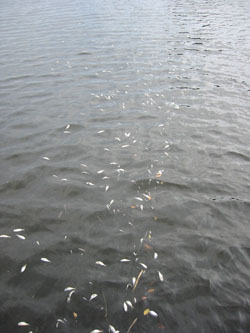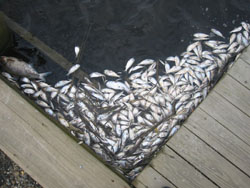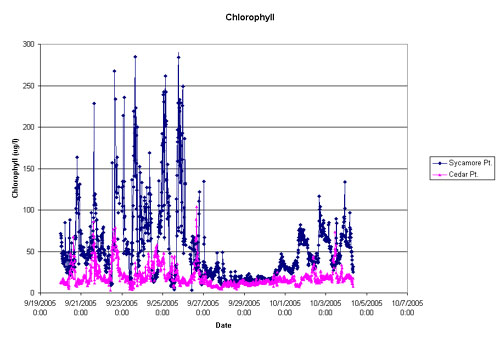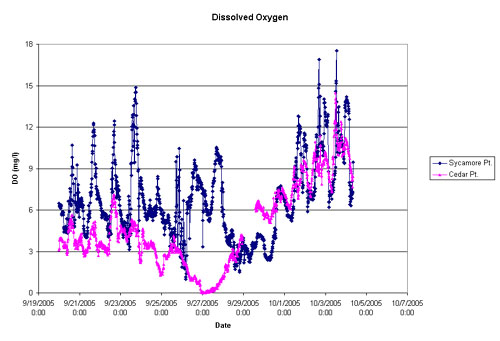October 5 ,
2005
Corsica River Fish Kill: Die-off of algae bloom leads to low dissolved oxygen and algal-produced karlotoxin effects on fish.
| October 5 ,
2005 |
A fish kill involving a few hundred fish was first detected by a water quality mapping field team Maryland Department of Natural Resources (DNR) on Monday morning, September 26, along the middle and upper Corsica River . Conversations with local citizens indicated that signs of fish in distress may have been occurring as early as Sunday, September 25. Water quality maps at this time indicated an algal bloom occurring in the upper reaches of the Corsica River.

The fish kill intensified and was further investigated by Maryland Department of the Environment (MDE) and DNR as it continued throughout the week. An estimated 50,000 fish had died by Thursday, September 29. Fifteen species were found on Tuesday by MDE, the most abundant fish were menhaden but also gizzard and hickory shad, sunfish, catfish, white and yellow perch, carp and killifish were observed. The fish kill is considered the result of combined stresses from low dissolved oxygen and the presence of sufficient karlotoxins in the water. Karlotoxins are specific potent chemicals that can affect fish health, associated with the algal species Karlodinium venificum , an abundant dinoflagellate found in the algal bloom.
 |
 |
 |
Data collected at the Maryland Department of Natural Resources (DNR) at Sycamore Point and Cedar Point continuous monitoring stations on the Corsica River show a persistent algal bloom during much of September with an abrupt decline in algal populations at the end of the month. Beginning September 23, dissolved oxygen started a downward trend below 5 mg/L, levels considered stressful to most fish. Total chlorophyll, an index of algae community size, declined and the decomposition of a large, dying algal community fueled conditions for further declines in dissolved oxygen. Oxygen levels reached 0 (called anoxia) on September 27 at Cedar Point. Upstream at Sycamore Point, conditions declined beginning September 24, going below 5 mg/L on September 25 and below 2 mg/L (called hypoxia) on September 27. A dinoflagellate, Karlodinium venificum , was abundant in the area with sample counts up to 56,000 cells per milliliter according to DNR. Karlodinium is known to sometimes produce a chemical thus far called karlotoxin that is potent to fish but not harmful to humans. Salinity records from continuous monitors also indicated a possible inversion or mixing of the water column. The upriver and downriver sites equalized at the same salinities, on September 25.
 |
 |
 |
Genetic testing for potentially harmful algal bloom species in the water samples was conducted by Holly Bowers at Dr. David Oldach's University of Maryland laboratory in Baltimore , MD. Karlodinium venificum was the only species testing positive in the ten species test.
Toxin testing for karlotoxin conducted by Dr. Allen Place's laboratory at the University of Maryland Biotechnology Institute's Center of Marine Biotechnology in Baltimore, MD showed the highest toxin concentrations among three samples collected on Monday were near Sycamore Point (1809 nanograms per milliliter). This level of toxin is nearly twice the level of 1000 nanograms per milliliter, shown in the laboratory capable of killing fish in 1 hour in the laboratory according to Jason Adolf and Tsetso Backvaroff of Dr. Place's lab. Levels of karlotoxin downriver were 410 and 229 nanograms per milliliter, subacute levels of toxicity.
The Cooperative DNR-National Oceanic and Atmospheric Administration Oxford-Sarbanes laboratory in Oxford , MD , will be conducting necropsy work on fish collected from the river. MDE and DNR returned to the river on September 29 to continue investigating the events. Approximately 9,000 dead fish were still observed in the upper Corsica River above the Centreville Boat Ramp. DNR staff also observed many dead Carp in stream reaches near MD Rt 213.
Continuous monitors on the Corsica River indicated high algal levels returning on October 1. An algal sample taken on the morning of October 4 at the Centreville public boat ramp showed Karlodinium concentrations of 5,512 cells/ml and a small centrate diatom at concentrations of 14,310 cells/ml. Continuous monitoring revealed chlorophyll levels decreasing on or about October 5, with subsequent dissolved oxygen levels at minimums of about 4 mg/l. The Maryland Departments of Natural Resources and the Environment will continue to monitor events on the Corsica River